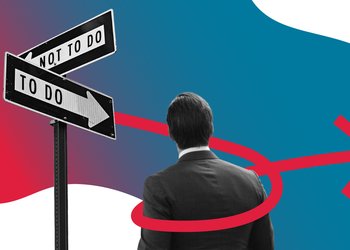The 15 Kaizen principles – How the best companies become even better

Kaizen is the Japanese word for “good change” (Kai = change, Zen = good), and describes the continuous improvement of all corporate functions, at all levels of the hierarchy.
Kaizen
is a competitive strategy in which all employees work together to create a
strong culture of constant improvement.
The core philosophy behind Kaizen is simple: you can always make or do things better, even if they seem to work well in a particular moment. Furthermore, all problems should be seen as opportunities to improve. We have written an extensive article about Kaizen philosophy here.
The best companies in the word are very well aware that they must constantly improve themselves, which is why they diligently follow the Kaizen philosophy.
To follow the Kaizen philosophy more easily and to make it a strong constant of a corporate culture, there are some ground rules and core Kaizen principles that managers should consider and embrace.
Let’s dive deep into these core Kaizen principles, and explore how they could be employed in your organization.
- The Kaizen principles – The foundations of constant improvement and unbeatable corporate culture in business
- 1. Don’t try to justify the past and the so-called “best practices”, start by questioning the best practices
- 2. Discard your fixed ideas, always keep your mind open to change
- 3. See waste and problems as an opportunity
- 4. You develop wisdom when faced with hardship
- 5. Maintain a positive attitude
- 6. Do not make excuses and eliminate can't - Think of how to do it, not why it cannot be done
- 7. Creativity before capital - do not spend money for kaizen, use your wisdom
- 8. Seek the wisdom of ten people rather than the knowledge of one
- 9. Understand the data and working principles, be data-driven
- 10. Learn by taking action, it’s called validated learning
- 11. Choose a simple solution, not the perfect one
- 12. Do it right away, even if you only aim at the 50 % target
- 13. If you make a mistake, correct it right away
- 14. Kaizen is endless
- 15. Have fun while implementing improvements
- The key takeaway from Kaizen principles: Even 1% improvement is fine
The Kaizen principles – The foundations of constant improvement and unbeatable corporate culture in business
As you might know, there were originally 10 principles of Kaizen, but of course, even these principles weren’t exempt from the philosophy of constant improvement, and a kaizen had to be made to the Kaizen rules.
That’s why we have added additional 5 rules. Following these rules will ensure that your organization will:
- constantly improve itself,
- grow faster, and
- create a winning corporate culture.
So, here are the Kaizen principles:
1. Don’t try to justify the past and the so-called “best practices”, start by questioning the best practices
All (organizational) cultures, no matter how large, have some kind of tradition and a cultural system designed to respect elders and carry over certain values and best practices from generation to generation.
These cultural systems can include everything from introducing rituals, symbols, unwritten rules, and sometimes even fairy tales, all the way to more formal etiquette and customs.
There’s absolutely nothing wrong with that, as long as the culture isn’t toxic and doesn’t stop progress and improvement. But, unfortunately, it often does.
When old rituals and best practices become an excuse for the status quo, it’s everyone’s duty to challenge it in a respectful and integrative way.
In many different groups, you can often hear thinking like:
- “we’ve always done it that way”, or
- "do exactly what your superior says because they know best”, and so on.
It’s very easy to justify and rationalize “best practice” pressure from the environment, and it’s really hard to be a misfit who wants to do it differently.
No matter how good and strong the tradition, there is always a way to do things better; otherwise we’d still be living in caves.
Everything that currently exists and is known as best practice can be improved if you try hard enough.
2. Discard your fixed ideas, always keep your mind open to change
Much like society has fixed ideas about how things should be done and it’s our job to challenge them, in the same way, we, as individuals, have fixed ideas that we always have to challenge.
Most often, we have fixed ideas about how to do things and what to value, simply because we’ve always done it that way (habits).
Always keep your mind open to change.
If you get fixated on a certain idea, start by asking yourself what would happen if you believed or did the opposite? Perform a mental exercise of defending the opposite belief or position.
You probably know the saying that the real test of first-rate intelligence is the ability to hold two opposing ideas at once and still retain the ability to function. So, open your mind and discard any fixed ideas.
3. See waste and problems as an opportunity
How would you like to be placed in front of a big opportunity, a once in a lifetime chance? Would you feel good and lucky to be in the right place at the right time and win big?
Well, opportunities like that are right in front of you, you just have to see them. All the big problems your company is facing are nothing but big opportunities.
Problems are opportunities to bring out solutions, to contribute value, to grow, to improve yourself, to contribute ideas, develop your talents, and consequently become better, more valuable, earn more, be more attractive, become stronger, and so on.
If you want to be valuable to your company, society, family and so on, you have to solve problems, fix things, and create value. It’s that simple.
Problems are your and your organization’s biggest opportunity. The more problems you see, the more ideas you should have. You can always turn waste into gold.
4. You develop wisdom when faced with hardship
If you want to constantly improve yourself, you need to develop more and more wisdom. Wisdom is basically the ability to think and act using knowledge, experience, understanding, common sense and insight.
Wisdom is about a deep understanding of things, incorporating tolerance for the uncertainties of life as well as its ups and downs.
Unfortunately (or not), the fastest way (if not the only way) we develop wisdom is when we’re faced with hardship and tough situations.
So, you shouldn’t be scared of hardship, but instead see it as an opportunity for the fastest improvement and growth.
You make good decisions based on extensive experience. You develop experience based on making bad decisions. Making several bad decisions slowly leads to making good and wise decisions. You can’t just be born wise.
5. Maintain a positive attitude
Maintaining a positive attitude is one of the most important rules of Kaizen. Only by keeping a positive mind can you see new opportunities; opportunities to grow yourself and your organization.
Only by keeping a positive outlook can you also foster the motivation to implement change and go after a better organizational environment.
Where there’s a will, a way is always found. A positive attitude and strong hope is what fuels a strong will. Without a positive attitude, you stop fighting, you stop innovating, you become blind to opportunities, and you start wasting your life.
There’s always a move you can make towards improvement, no matter how hard the situation is. Never forget that. That’s how kaizen masters think.
6. Do not make excuses and eliminate can't - Think of how to do it, not why it cannot be done
Even with a positive attitude, you can still end up accepting the status quo. You can stay positive, accepting the situation as it is and believing that an improvement simply isn’t feasible.
However, this mindset is completely wrong, no matter how credible an excuse exists.
There’s always an improvement that can be made if you keep innovating hard enough. Don’t use your mental power to look for excuses as to why things cannot be done.
Eliminate can’t once and for all. Start thinking about how to do it, if you really want it done.
If your mind feels trapped, and you have no idea what your next step might be, and all you can see are excuses, then you must first start by un-sticking your mind.
There are hundreds and hundreds of ways how you can innovate, improve, and look for creative solutions.
You can look at the situation from a different angle, you can look for:
- simpler,
- faster,
- cheaper solutions,
- you can present things better,
- establish new relationships,
- better time management,
- and so on.
If you have a positive attitude, if you care enough and keep your mind open, all of this is possible. Remember, your mind is like a parachute, it only works when it’s open.
7. Creativity before capital - do not spend money for kaizen, use your wisdom
There are, more or less, two ways of finding ideas for positive change. You can use money to hire people, and invest in new technologies etc. or you can use your own creativity.
At some point it makes sense to pay for new ideas, knowledge, and technologies, but you have to start with your own creativity. So why is this?
There’s no way a change will be implemented permanently if there isn’t enough motivation on the table. If enough motivation is present, there will be many creative ideas for positive change.
If there are no internal ideas, there’s probably no motivation, and if there is no motivation, change won’t last for long.
No matter how good the experts or the technology you pay for are, things will start to collapse and everything will go to its old ways if there isn’t enough motivation, together with all the possible persistence, resilience, consistency, and discipline.
The change must always start from within.
8. Seek the wisdom of ten people rather than the knowledge of one
In the information age, there’s a rule that you have to go for the best knowledge right away. We produce and duplicate so much information that you can easily get lost in bad advice and useless info.
So, you have to be extremely picky about what information you consume.
Nevertheless, you should never seek the knowledge of only one person. Everyone has their own interpretation of the world (subjective reality) and everyone sees the situation from a different angle.
The more angles you understand, the closer you can get to the objective reality (the truth). Consequently, you better understand the problem and what needs to be done.
In addition, the more ideas you receive, the easier you can integrate them and innovate further.
9. Understand the data and working principles, be data-driven
Every change must be data-driven. You somehow have to measure whether you have really found a new way to do things better. You can’t just assume, because incorrect assumptions are the mother of all disasters.
You must be obsessed with data, dashboards, metrics and measuring when making improvements. You can improve only the things that you measure.
You must always know what exactly you’re trying to improve and on which metrics that improvement is based. When implementing a new positive change, it should always be in connection with the one metric that matters most at a certain time in a certain situation.
The fact is, you always have to put data before rhetoric when implementing changes.
10. Learn by taking action, it’s called validated learning
You learn the most by doing things. It’s called “Genchi Gembutsu” in Japanese or “Leaving the building” in English. You can read 100 books on how to swim, but it can never compare to actually doing it.
You can’t implement change based only on theoretical knowledge. You must become a master of validated learning and superior insights into how things work.
11. Choose a simple solution, not the perfect one
Simplicity is always better than complexity. Implementing change is hard, and implementing complex change is even harder, if not close to impossible.
Therefore, choose a simple solution you can start implementing immediately. A successfully implemented small change will motivate you to implement new and bigger changes.
By doing so, you will increase your capacity and stamina for more complex change. Small progress can always lead to bigger progress, but in the beginning, forget about the big steps and start small.
Choose simple solutions to start with. Never be afraid to progress slowly in the beginning, only be afraid of stopping.
12. Do it right away, even if you only aim at the 50 % target
When new ways of doing things come to mind, you should immediately try them and measure the results. If you aim at a 50 % target and it works, the final 100% is within reach, the important thing is that you take the first step.
In addition, when you make the first step with the implementation, you start observing, learning, and getting feedback from the environment. You gain the ability to adjust your strategy according to the forces in the environment.
It’s more probable that you will get to 100 % if you first aim at 50 % and then adjust based on feedback, than if you aim at 100 % with broad and overly-complex solutions.
13. If you make a mistake, correct it right away
When innovating and improving things, you constantly make mistakes. You constantly fail and discover options that don’t work. You probably know how many attempts were necessary before the light bulb was invented.
When improving yourself, you will make mistakes. You will find ways that don’t work, and you will find ways that are less efficient than your current ones. You will be frustrated, and your willpower will be tested.
But mistakes and failure are not to be feared. Failure is an integral part of every success. That being said, there is one important rule to consider, and that is to correct your mistakes right away.
Don’t let mistakes grow and turn into something uncontrollable and unmanageable. Have the courage to admit you’ve made a mistake and correct it immediately. Always do damage control.
14. Kaizen is endless
The best thing about Kaizen is that it is endless. No matter how many changes you’ve already implemented there is always a way to do it better. There is always a way to improve something.
There’s no such thing as practice, and there’s no such thing as being on the top. You should strive for nothing else but constant improvement all the way to your last breath.
Imagine how life will be in 50, 100 and 500 years - full of evolutions and revolutions - in other words improvements.
And there’s another important factor in that environments are constantly changing for the better with new technologies, new processes etc.
If you stop improving, you start lagging behind.
Your aim should be to improve faster than the environment is. Think about what would happen if Apple stopped improving and stopped releasing new products, just because they’re the most valuable company on the planet. They would obviously go out of business in a few years.
So, never stop improving.
15. Have fun while implementing improvements
Last but not least, you must have fun implementing positive change. It must become part of your character, a part of the organizational culture. You have to stay lean, agile, adaptive and always look for improvements, all the while not forgetting to have fun.
If you don’t find fun in changing yourself and improving your organization, Kaizen is nothing but struggle and hard work, which nobody wants.
With a positive approach, pride in the improvements you’ve made and the ability to see everything as a challenge, Kaizen can be fun.
When something is fun, we want to do it more.
The key takeaway from Kaizen principles: Even 1% improvement is fine
Implementing any kind of positive change starts with the right mindset – among individuals, teams, and the organization’s collective as a whole. But often nobody really likes change, even if they say they do.
However, that shouldn’t stop you from innovating and finding better ways to do things in your organization.
You must become the light of positive change, a person with a Kaizen mindset. You must inspire your coworkers and other business partners to achieve the same.
And if your mind gets stuck, and it will, you should immediately revise these Kaizen rules, un-stick yourself and restart your self-improvement, the improvement of the people around you, and the improvement of your organization.
No matter how hard the situation is, be known as a Zenkai -a master of Kaizen in your organization. In the end, even 1 % improvement is fine, as long as you keep going.






